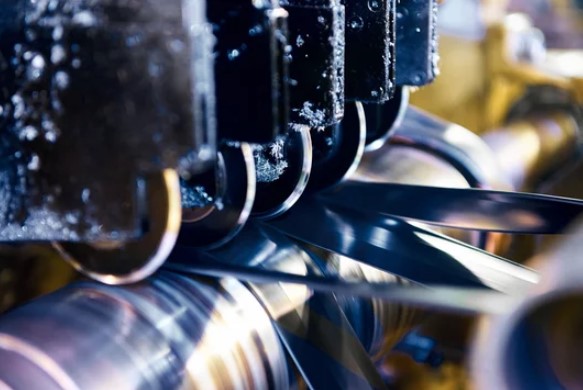- 0.1 PLASTIC GASKETS PRODUCTION FOR INDUSTRY: THE CUSTOMER
- 0.2 SEPARATING TOLUENE BY DISTILLATION: THE GOAL
- 0.3 TOULENE SOLVENT: THE PHYSICAL CHARACTERISTICS OF ATMOSPHERIC EMISSIONS
- 0.4 TOULENE SOLVENT: THE SOLUTION THROUGH THE RECOVERY PROCESS WITH STEAM REGENERATION
- 0.5 TOLUENE RECOVERY
- 0.6 THE RECOVERY OF SOLVENT MIXTURES: separating toluene by distillation
- 1 Toulene solvent: the achievements of the recovery plant.
Toluene recovery in gaskets production and plastics calendering processes.
SECTOR
TOLUENE (TOLUENE FORMULA: C7H8 ), ALSO KNOWN AS TOLUOL, IS A LIQUID, VOLATILE, COLORLESS SOLVENT WITH THE CHARACTERISTIC ODOR OF PAINT THINNERS. TOLUENE IS CLASSIFIED AS A HIGHLY HARMFUL AND EASILY FLAMMABLE SUBSTANCE, SO BEING ABLE TO RECOVER AND REUSE IT IN INDUSTRIAL PRODUCTION PROCESSES IS CRITICAL TO REDUCING ENVIRONMENTAL POLLUTION, ENSURING WORKER SAFETY AND REDUCING PRODUCTION COSTS.

PLASTIC GASKETS PRODUCTION FOR INDUSTRY: THE CUSTOMER
The client at issue in this case study is a well-known manufacturer of ultra-high-strength industrial seals that uses, among other materials, PTFE, a fluorinated polymer with very high heat and chemical resistance; the company asked us to help reduce the emission to the atmosphere of solvents used in calendering (plastic deformation). Calendering is used to produce continuous sheets or films of controlled thickness, in this case to produce the material from which gaskets are made, and is done by compressing the plastic mass, kept in a suitable temperature range, between a pair of heated, counter-rotating rollers.
SEPARATING TOLUENE BY DISTILLATION: THE GOAL
The main goal of the plant is to treat the emissions containing toluene that are released into the atmosphere during the calendering process in order to comply with the emission limits and to be able to recover the solvent for reuse in the same industrial process.
The plant is designed so that the treatment of a different solvent composition can be considered in the future.
TOULENE SOLVENT: THE PHYSICAL CHARACTERISTICS OF ATMOSPHERIC EMISSIONS
The air emissions that characterize the calendering process are as follows:
Because toluene has a low freezing point and a high boiling point, it is ideally suited for use in calendering processes where temperature control is critical; therefore, it is used to dilute the compounds of materials that must be calendered to obtain the product from which industrial seals are to be made
The solvent is collected at various stations near the calendering machines, the mixers that produce the compounds to be calendered, and the ovens that bake the calendered product.
| VARIABLE | CARACTERÍSTICAS |
|---|---|
| Temperatura mín. | 20 °C |
| Temperatura máx. | 70 °C |
| Presencia de compuestos orgánicos volátiles (COV) | Methylbenzene (Toluene) 100% |
| Tasa de tolueno emitido | 200 – 250 kg/h |
| Caudal del aire | 20.000-50.000 Nm3/h |
| Ciclo de servicio | En varios turnos diarios |
TOULENE SOLVENT: THE SOLUTION THROUGH THE RECOVERY PROCESS WITH STEAM REGENERATION
TOLUENE RECOVERY
Because toluene is a solvent that is easily adsorbed on activated carbon and not soluble in water (see further discussion: Solvent regeneration with activated carbon: when to use steam and when inert gasses), the choice of recovery technology fell on adsorption with activated carbon and steam regeneration
THE RECOVERY OF SOLVENT MIXTURES: separating toluene by distillation
As anticipated in the previous section, the design of the plant took into account the client’s request to have a technology also suitable for the future recovery of a mixture of various solvents, potentially also soluble in water.
In order to ensure that recovery is still efficient , solutions were identified, some of which were installed in the first phase, and others to be installed in the future
Installations planned in the first phase:
- The main components of the plant were made of materials compatible with contact with solvent mixtures.
- The main components of the plant have been oversized for use under more severe conditions resulting from the presence of solvent mixtures
In the eventual second phase, the facility may be implemented with additional modifications:
- Increasing the amount of activated carbon
- Installation of a distillation unit that allows separation of toluene from other solvents according to the composition required by the customer, to enable maximization of reuse
Toulene solvent: the achievements of the recovery plant.
The plant met all the requirements that the customer had set as fundamental, including compliance with the strictest environmental regulations and the recovery and reuse of toluene with a degree of purity comparable to the product that can be purchased on the market.
The operating costs proved to be highly sustainable, confirming the customer’s expectation that the investment would pay for itself in a short time, so the recovery solution was preferred over the purchase solution.
The technical solution identified is also in perfect harmony with the philosophy of the client, which promotes the use of advanced ecological solutions that are also ecologically sustainable and oriented towards “clean” industrial production models that favor the reuse of the products and also have a lower CO2 impact.